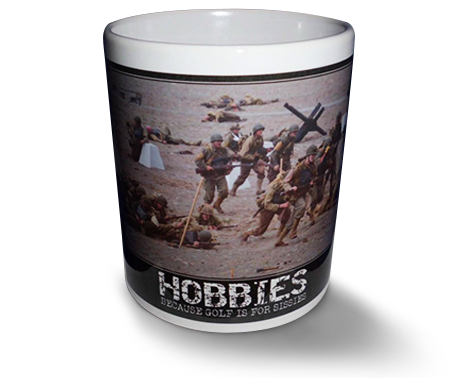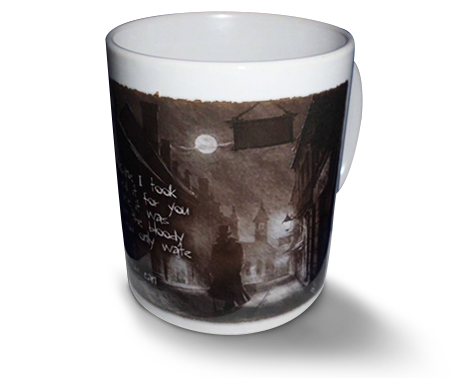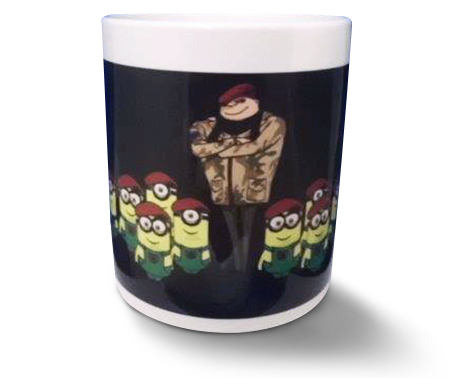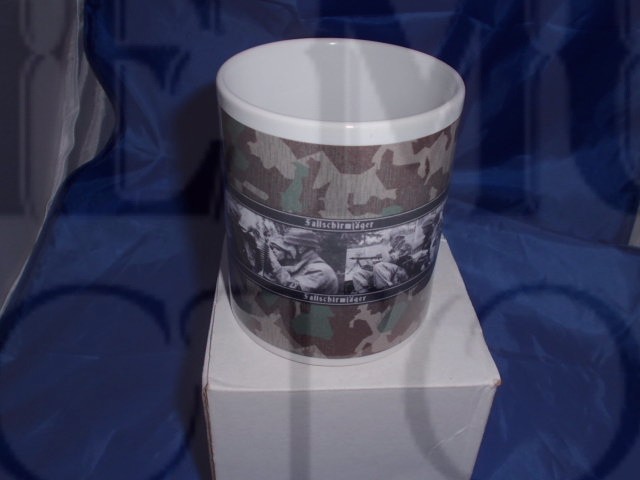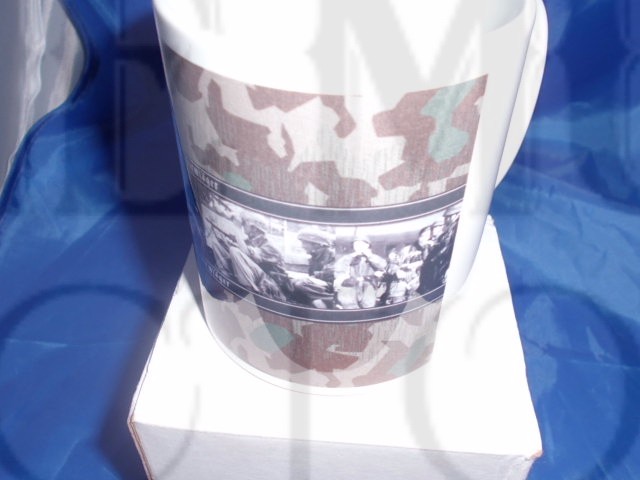Fallschirmjager personalised military mug
11oz Dishwasher safe fallschirmjager mug
No other troops in the world but German paratroops could have stood up
to such an ordeal and then gone on fighting with such ferocity.
- Field Marshal Alexander at Monte Cassino Abbey, February 1944
Ten Commandments of the German Fallschirmj ger
You are the one of the German Army. You will seek combat and train yourselves. To you, battle shall be the fulfillment.
Cultivate true comradeship, for the aid of your comrades you will conquer or die.
Beware of talking. Be not corruptible. Men act while women chatter. Chatter may bring you to the grave.
Be calm and prudent, strong and resolute. Valour and enthusiasm of an offensive spirit.
The most precious thing in the presence of the foe is ammunition. He who shoots uselessly, just to comfort himself, is a man of straw who is not the title of parachute.
Never surrender; To be able to do it.
You can triumph only if your weapons are good. See to it that you submit to this law - first thy weapon, then thyself.
You must grasp the full purpose of every enterprise, so that if your leader is killed you can fulfill it.
Against an open foe, fight with chivalry, but to a guerrilla, extend no quarter.
Keep your eyes wide open. Tune yourself to the utmost pitch. Be nimble as a greyhound, tough as leather, hard as Krupp steel. You will be the German warrior incarnate.
Ten Commandments of the Parachute
You are a member of the German Army!
You will seek the struggle and train you to endure any kind of examination.
For you to be the battle fulfillment.
Careful camaraderie, for by the help of your comrades you will be victorious or die!
Be the first. Do not be corruptible! Men act while women are chatting. Talking can take you to the grave!
Be calm and careful, strong and determined! Bravery and enthusiasm of an attack spirit, the upper hand will be left in the attack.
The most valuable aspect of the enemy is ammunition. The one who shoots unnecessarily, just to calm down, does not deserve the name "parachute".
You can only be victorious if your weapons are good. Make sure you adhere to the law: "First my weapon and then I"!
You must understand the full meaning of each business, so that if your leader fills you, you can act on your own. Against an open enemy fighting with chivalry, against a partisan would not grant a pardon!
Keep your eyes open! Be agile like a greyhound, as tough as leather, as hard as Kruppstahl, only so will you become the cloak of the German warrior.
Important Disclaimer! - This is a non-political web page dealing with the history, equipment, life and campaigns of the World War II German airborne soldier (Fallschirmj ger) and World War II reenacting. This website is about historical information as well as reenacting and living history information. This information includes reenactment photos, historical information covering operations, equipment and photos of World War II parachute in action. The World War II German airborne unit. The World War II German airborne unit. We do not tolerate or condone any form of racism, radical or extremist activities, or persons with supremacist, Fascist or racist political motives or beliefs and we do not support nor glorify the reprehensible policies of the Nazi Party. We do not tolerate, support, or condone any activities of any neo-nazi party organizations, any extremist, anti-immigrant or anti-semetic organizations.
1930s Hermann Göring, after having observed Soviet airborne infantry maneuvers, became committed to the creation of Germany's airborne infantry. He ordered the formation of a specialist police unit in 1933, devoted to protecting Nazi party officials. The unit carried out conventional police duties for the next two years, but in 1935, Göring transformed it into Germany's first dedicated airborne regiment. The unit was incorporated into the newly formed Luftwaffe later that year and training commenced. Göring also ordered that a group of volunteers be drawn for parachute training. These volunteers would form a cadre for a future Fallschirmtruppe ("parachute troops") In January 1936, 600 men and officers formed a Jäger and an engineer company.Germany's parachute arm was officially inaugurated in 1936 with a call for recruits for a parachute training school. The school was open to Luftwaffe personnel, who were required to successfully complete six jumps in order to receive the Luftwaffe parachutist's badge.
During World War II, the German Air Force (Luftwaffe) raised a variety of airborne light infantry (Fallschirmjäger) units. The Luftwaffe built up a division-sized unit of three Fallschirmjäger regiments plus supporting arms and air assets, known as the 7th Flieger Division. Throughout World War II, the Fallschirmjäger overall commander was Kurt Student.
Fallschirmjäger participated in the occupation of Norway and Denmark and in the battles of Belgium, the Netherlands and France in 1940. They also took part in the Balkans Campaign, Battle of Crete, Italian Campaign, and on both the Eastern Front and later the Western Front would follow.
Bundeswehr Fallschirmjäger
At the 2007 Bastille Day Military Parade.
In the modern German Bundeswehr, Fallschirmjäger continue to form the core of special operations units. The division has two brigade equivalents and several independent companies and battalions. All told, about 10,000 troops served in that division in 2010, most of them support or logistics personnel.
The vast majority of division members are deployable by parachute, and all of it is at least air mobile. Almost all vehicles and heavy equipment are transportable by helicopter, including special lightly armoured Wiesel heavy weapon transport vehicles adopted for this purpose. In addition to the Special Operations Division, Germany is also setting up an air mobile or air assault regiment.
National People's Army
NVA Fallschirmjäger Uniform.
40. Fallschirmjägerbataillon Willi Sänger was the only airborne infantry formation of the Nationale Volksarmee (NVA). The battalion and its airborne-commando school were based in Prora on Rügen (1961–82) and near Potsdam (1982–90). Officially, the battalion was an airborne unit organized as an NVA light infantry battalion, but in reality it was considered a commando unit. On mission, the companies of the battalion were to be split up into teams of five or six men. As a force with special capabilities, it remained under the direct command of the army high command (Kommando Landstreitkräfte, KdoLaSK).
The reconnaissance company of the Felix Dzerzhinsky Guards Regiment (German: Wachregiment "Feliks E. Dzierzynski"), an elite motorized rifle regiment of the Ministry for State Security of the German Democratic Republic (GDR), was a parachute-trained unit.
Following the invasion of Krete over 100 civilians were killed by a team of Fallschirmjager led by Oberleutnant Horst Trebes on the order of Generaloberst Kurt Student in retaliation for their involvement in the killing and mutilation of several dozen paratroopers who caught in trees during the landings. Everywhere on the island, Cretan civilians, armed and otherwise, joined the battle with whatever weapons were at hand. Cretan civilians went into action armed only with what they could gather, and many Fallschirmjäger were knifed or clubbed to death as soon as they landed. An elderly Cretan was said to have clubbed a parachutist to death with his walking stick before the German could disentangle himself from his parachute lines. The Cretans actions were not limited to harassment since the civil population also played a significant role in the Greek counter-attacks at Kastelli Hill and Paleochora. This was the first time that Germans had encountered broad resistance from a civilian population, and it was initially shocking for them. Fallschirmjäger reacted with equal ferocity after recovering. The Cretans were regarded as partisans since they wore no identifying insignia or even armbands, the German authorities felt free of the constraints implied by the Geneva conventions. Further enraging the Fallschirmjäger were rumours of battlefield mutilations by civilians torturing injured Fallschirmjäger. However the book 'The Lost Battle', by MacDonald argues that battlefield mutilations were more than likely a result of carrion birds and physical decay of corpses left in the extreme heat. In the village of Kondomari more than 100 civilians were rounded up and executed by Fallschirmjäger. Franz Peter Weixler, Wehrmacht kriegsberichter (Army war correspondent) photographed and preserved his negatives of the massacre. Weixler was later charged with treason and held by the Gestapo. Here is an English translation his original statement for the trial of Hermann Goering. Fallschirmjäger fought tenaciously during every engagement, however they were known to be fair and when combat was over they cared for the wounded without regard to their allegiance. They were known for their fair and correct behavior and adherence to the Fallschirmjäger commandments. Generaloberst Student was convicted of the crime in 1946 by a British tribunal, the conviction was later overturned. However this killing of civilians was a huge stain on an otherwise soldierly deportment of the Fallschirmjäger during the war. Photos from the Bundesarchiv taken by Wehrmacht kriegsberichter Franz Peter Weixler, Oberleutnant Horst Trebes of the Luftwaffe conducted the shootings.
During the airborne operation in Kreta the Fallschirmjäger were equipped with the same type of small arms as the Heer, with pistols and hand grenades on jumps, and submachine guns, rifles and other weapons dropped in containers. In Kreta long-range fire from the defender caused heavy casualties before they could retrieve their main weapons. This caused rethinking of the use of standard weapons for paratroops. Additionally newer semi-automatic arms were being developed for the Heer during this period. The Reich Air Ministry proposed a broad use automatic rifle to replace the other arms used by the Fallschirmjäger. This would simplify logistics for airborne operations as well, since neither the bolt action carbine nor short range submachine guns were adequate for airborne combat operation. Encountering resistance and conflicting priorities from other procurement entities in the Reich Hermann Göring ordered the project to continue independently.
RLM went directly to six German arms manufacturers with the LC-6 specification on 14 Dec 41. The initial design specifications were; not exceed 1,000 mm (39.4 in) long, no heavier than a Kar 98k rifle, selectable fire and use a detachable magazine for 7.92x57mm Mauser round. One interesting design point was the extreme cant to the grip, ostensibly to enable the Fallschirmjäger to fire downward while suspended under canopy. The selected design was from Rheinmetall-Borsig. The designer was Louis Stange. After several prototypes the LC-6/III variant was accepted for production as the Fallschirmjägergewehr-42 (FG 42). Fifty rifles were created by Rheinmetall for evaluation by the close of 1942. Some of these weapons experienced serious malfunctions and deformation. These malfunctions were fixed as were several other modifications and the weapon was authorized for limited production, approximately 2000 of this first Type E were manufactured. The weapon was first used in combat by Fallschirmjäger during operation to rescue Benito Mussolini.
Once deployed in the field it was found that the lightweight rifle wasn't sturdy enough to handle full power rifle ammunition in full automatic. In early '44 Krieghoff engineers designed Type G. It was longer and heavier, the stock was made from wood instead of steel, the grip was changed to vertical, the magazine design was changed. A four position gas regulator was fitted, the bolt and recoil spring were changed to wound wire, a case deflector was fitted and the muzzle brake and bayonet mount were changed. While all new FG-42 rifles had an integral dovetail, which accepted mounts for the ZF-41, scope equipped FG42's were very few and far between in the actual field. Scope equipped FG-42's mainly reside in collections with the ZF scope added post war.
The classifications are as follows:
Type A - First design
Type B - Revised model prototype
Type C - "LC-6" Prototype
Type D - First Fallschirmjägergewehr; acceptance trials
Type E - First production Fallschirmjägergewehr (sometimes called the "Type I")
Type F - First stamped receiver Fallschirmjägergewehr
Type G - Final production model Fallschirmjägergewehr (sometimes called "Type II")
FG-42 is a gas operated, air-cooled, selective fire weapon, with a long stroke gas piston under the barrel, and it operates the rotating bolt with two lugs. The gas system of the Type G added a gas adjustment regulator. The trigger unit was designed to fire from closed bolt in single shots for accuracy, and open bolt in full auto for better cooling.
The FG-42 underwent continuous development, changes suggested from the field included changing the metal stock to wood for better insulation from heat during prolonged fire and a larger forestock. The bipod attachment point was moved forward and the grip became more vertical. This became the Type G and again had a small production run of about 5000 units.
Specifications:
Type E
Type G
Caliber
7.92x57 mm
7.92x57 mm
Overall length
940 mm
1060 mm
Barrel length
508 mm
525 mm
Empty weight
4.38 kg
5.05 kg
Rate of fire
900 rpm
600 rpm
Magazine capacity
10 or 20 rounds
10 or 20 rounds
Option 1 - Buy an original
Out of the question for all but the wealthiest of people. However here is a website with some photos to drool over; claus.espeholt.dk/fg42.html. A couple of examples below, Type E on the left, Type G on the right.
A video of a field strip of Type E (Shoei reproduction)
A Wikipedias entry on the FG-42
Option 2 (Best) - Get in queue for the SMG Guns FG42 II Project
SMG Guns brought out two prototypes to March on Rome II, one was taken into the field for Saturday's battle by Hauptmann Zimmerman of FJR/2. The other we live fired at the range at Fort Stanton's former German WWII Internment Camp.
I got to fire about 10 rounds! All I can say is it's a sweetheart! Nice feel, it's heavier than an G43 (more comparable with an M-14). But when you put it to your shoulder you see it's way shorter. The sights are high but good and the recoil is very light... a bit more than a .223 AR15 but lighter than AK47. The trigger is nice and smooth on recoil it pushes a little up and right; just pull it back and its easily back on target. The handguard insulates from the heat, the barrel and bipod got a hot after multiple people had fired almost 175 rounds downrange.
It's probably about 8-10 weeks away from shipping (just my opinion) as it still needs the mag well doors and the grooving on the forestock but it's pretty close. Both the blue and the phosphated ones look really good. We also took a bunch of photos here: FG-42 at March on Rome.
MoR II Axis Commander with SMG FG-42
Rick of SMG Guns prior to the live shoot
New info SMG Guns has a really good detail page on the ordering process and details on the FG-42 updated. It's at this link: SMG Future FG42 buyers info/specs.
SMG Guns has received ATF approval for the FG42 rifle: 04-21-11. Details here.
I'm on queue for one of these, so get in line behind me! SMG already has a proven track record with the reenactment community with their DP-28, Bren Guns, PPsH, and ZB-26 offerings. They have a prototype and they are well on the way with production parts manufacture for an initial production run of 20 FG-42s!
An image from SMG Guns Website, wow does this FG-42 look good…
The company has a good reputation. Of the initial run, 10 will be sold to people on the queue, there will be another 10 sold at auction, so the initial run will be 20 for some very lucky enthusiasts. Of course they will building more since they are the manufacturer!
I am looking forward to mine and see absolutely no problems in using it re-enacting as long as I’m attending an event where it would be appropriate and historically accurate to carry the FG-42… it looks that good!
I absolutely love my FG42 II! I hope to be posting some better photos of it on the site soon. I fell in love with the rifle when Rick at SMG brought two out to the March on Rome event and let us live fire it. I got mine just a few weeks ago and took it straight to the range. My first 4 rounds punched a 4" circle at 100 yards. It's a nice shooter right out of the box. I was mobbed after I came out of the active range area... a lot of folks recognized what it was - or what they thought it was - an original FG42. They were no less impressed with it knowing it was a replica.
Option 3 - (If you have a Federal armaments import license) - HZA Kulmbach GmbH & Sport-Systeme Dittrich
Sport-Systeme Dittrich makes several nice Sturmgewehr MP-44 and other rifles as well. However without the armaments import license, you aren't going to get one from Germany. They have both model I and II available. Here are two catalogues One and Two on their website.
Paratrooper rifle BD 42/I (FG42 first model)
Paratrooper BD 42/II (FG42 second model)
Option 4 - (If they are still in business) - FG42 INC. - Everson, Washington
Unfortunately the last entry on their website was Dec 24th 2009 without much news since. The project looked good however the price which started at $4,000 went to over $14,000 at one point, though it looks as though there won't be any FG42 any time soon.
Reference - (Learn more)
Death From Above: The German FG42 Paratrooper RiflePublisher: Collector Grade Publications Inc., PO Box 1046, Cobourg, Ontario, K9A 4W5 Canada
Authors: Thomas B. & R. Blake Stevens Dugelby, First edition 1990, expanded edition 2007.
ISBN: 0-88935-429-4
Excellent book with many photos covering both models of the FG-42.
Translation of the German Manual by John Baum This is a translation of the original FG 42 (Type E) Operator's Manual. The manual is 79 pages with 37 illustrations, cost; $20 – includes U.S. first class postage. Web link to order.
The cover and an illustration from Baum's translated manual...
Accessories - (For reenactors)
Bandoliers - Like all reenacting ebay is a prime source. Spearhead Militaria has several types of Fallschirmjäger FG-42 bandoliers. I've received the bandolier, and I like it. It's made of good quality fabric and is full size unlike his K98 bandoliers which are really small and short compared to the originals. The pockets are genrously sized. I don't have any FG-42 magazines to compare them to but the photo shows a FN-FAL mag and a G3 Mag. both of them fit easily with room to spare.
Slings - Here's a couple of photos of an original sling, sort of a combination between an MG sling and Mauser sling.
Blanks - Actual experience information here.
Magazines - SMG Guns will be supplying two magazines for each FG-42. The aftermarket magazine that will work is also the magazine used in the Czech ZB-26. IMA USA has these ZB-26 magazines for $50 each currently.
Bayonets - A special spike style bayonet is used by the FG-42 it is very similar to the French MAS 36 bayonet.SMG Guns has several photos on their web site of a Shoei replica bayonet (very close to the original) and of a shortened MAS 36 bayonet mounted on the FG-42. The FG-42 bayonet was 11.81 inches for the Type I,and 10.43 inches for Type II.
The French MAS 36 bayonet is 16.93 inches for the rifle version and 15.12 inches for the Paratrooper version. These bayonets are available at IMA USA for less than $40 currently.
Looking at the difference between the MAS bayonet and the Shoei replica it seems the knurled portion is shorter and more finely knurled and the shoulder of the round portion has a sharper transition. I'll reshape my MAS bayonet on the lathe to match the profile a bit more after I shorten it. It should make a fine finishing touch!
Parts - SMG Guns will be stocking and providing spare parts.
Bundesarchiv Photos
Selected bundesarchiv photos of FG-42 in the field.
Important Disclaimer! - This is a non-political web page dealing with the history, equipment, life and campaigns of the World War II German airborne soldier (Fallschirmjäger) and World War II reenacting. This website is contains historical information as well as reenacting and living history information. This information includes reenactment photos, historical information covering operations, equipment and photos of World War II Fallschirmjäger in action. The information is catalogued and presented to preserve a clear eyed view of military history and present to the public an accurate representation of a World War II German airborne unit. We do not tolerate or condone any form of racism, radical or extremist activities, or persons with supremacist, fascist or racist political motives or beliefs and we do not support nor glorify the reprehensible policies of the Nazi Party. We do not tolerate, support, or condone any activities of any neo-nazi party organizations, any extremist, anti-immigrant or anti-semetic organizations.

